The Impact of Urban Street Network on Land Value: Correlate Syntactical Premises to the Land Price
Abstract
1. Introduction
2. Literature Review
2.1. Urban Spatial Network in Literature
2.1.1. Urban Street Network
2.1.2. Street Accessibility
2.1.3. Street Function
2.1.4. Urban Street Classifications
2.2. Urban Economy in Literature
2.2.1. Land Market Theory
2.2.2. The Concept of the Land Value and Land Price
2.3. Urban Configurational Syntax Theory
3. Materials and Methods
3.1. Case Study Social, Economy, and Environment Background
3.2. Sampling System and Data Collection
4. Analysis and Results
4.1. Land Price and Syntactical Street Network Analysis
4.2. Street Classification and Land Price
5. Discussion
6. Conclusions
Author Contributions
Funding
Institutional Review Board Statement
Informed Consent Statement
Data Availability Statement
Acknowledgments
Conflicts of Interest
Appendix A
| Case Number | Samples | Land Price | Integration | Connectivity | Street Width |
|---|---|---|---|---|---|
| 1 | Setwan LR * | 300 | 0.2047 | 4 | 10 |
| 2 | Setwan CR * | 400 | 0.2221 | 4 | 12 |
| 3 | Setwan C * | 500 | 0.2477 | 5 | 15 |
| 4 | Zerinok LR | 500 | 0.2453 | 3 | 10 |
| 5 | Zerinok CR | 1250 | 0.2773 | 4 | 20 |
| 6 | Ibrahim ahmad LR | 350 | 0.2137 | 4 | 10 |
| 7 | Ibrahim ahmad CR | 450 | 0.2391 | 4 | 20 |
| 8 | Ibrahim ahmad C | 1500 | 0.277 | 9 | 30 |
| 9 | Qrga LR | 280 | 0.1973 | 6 | 12 |
| 10 | Qrga CR | 400 | 0.2272 | 4 | 20 |
| 11 | Qrga C | 1000 | 0.2586 | 7 | 30 |
| 12 | Tasluja LR | 50 | 0.1414 | 4 | 7 |
| 13 | Tasluja CR | 200 | 0.2244 | 6 | 10 |
| 14 | Tasluja C | 500 | 0.244 | 5 | 20 |
| 15 | kandaswra LR | 100 | 0.1602 | 4 | 6 |
| 16 | kandaswra CR | 300 | 0.2058 | 4 | 15 |
| 17 | qularaisy LR | 150 | 0.1858 | 5 | 7 |
| 18 | qularaisy CR | 300 | 0.2276 | 4 | 10 |
| 19 | Rapareen LR | 250 | 0.197 | 4 | 20 |
| 20 | Rapareen LR 1 | 125 | 0.1848 | 4 | 7 |
| 21 | Rapareen CR | 450 | 0.2948 | 3 | 20 |
| 22 | Rapareen CR 2 | 300 | 0.2048 | 4 | 15 |
| 23 | Rapareen C | 1600 | 0.2964 | 11 | 30 |
| 24 | Rapareen C 3 | 1000 | 0.2838 | 5 | 30 |
| 25 | Farmanbaran LR | 350 | 0.217 | 4 | 8 |
| 26 | Farmanbaran CR | 500 | 0.2593 | 4 | 8 |
| 27 | Farmanbaran C | 1400 | 0.3105 | 9 | 30 |
| 28 | Majy bag LR | 350 | 0.2306 | 4 | 6 |
| 29 | Majy bag CR | 400 | 0.2355 | 6 | 10 |
| 30 | Majy bag C | 850 | 0.2746 | 8 | 22 |
| 31 | Khabat LR | 300 | 0.2572 | 6 | 7 |
| 32 | khabat CR | 350 | 0.2867 | 6 | 12.5 |
| 33 | khabat C | 1300 | 0.3127 | 9 | 26 |
| 34 | qazi muhamad LR | 400 | 0.2891 | 4 | 7 |
| 35 | qazi muhamad CR | 750 | 0.3103 | 4 | 7 |
| 36 | qazi muhamad C | 2500 | 0.3332 | 11 | 22 |
| 37 | Bakrajo LR | 200 | 0.1914 | 3 | 7 |
| 38 | Bakrajo CR | 650 | 0.2508 | 5 | 12 |
| 39 | Bakrajo C | 1500 | 0.2862 | 6 | 22 |
| 40 | Hawary Shar LR | 300 | 0.2345 | 5 | 7 |
| 41 | Hawary Shar CR | 700 | 0.2668 | 4 | 10 |
| 42 | Hawary Shar C | 1500 | 0.2716 | 8 | 22 |
| 43 | Sarchnar LR | 350 | 0.241 | 3 | 10 |
| 44 | Sarchnar CR | 650 | 0.2992 | 4 | 10 |
| 45 | Sarchnar C | 2200 | 0.3137 | 11 | 20 |
| 46 | Azadi LR | 350 | 0.2425 | 4 | 6.5 |
| 47 | Azadi CR | 650 | 0.2975 | 3 | 7 |
| 48 | Azadi C | 2200 | 0.3145 | 13 | 17 |
| 49 | Ibrahim pasha LR | 350 | 0.2633 | 6 | 5.5 |
| 50 | Ibrahim pasha CR | 600 | 0.298 | 4 | 8.5 |
| 51 | Ibrahim pasha C | 2000 | 0.3046 | 11 | 22 |
| 52 | Zargatay kon LR | 400 | 0.2657 | 4 | 10 |
| 53 | Zargata CR | 650 | 0.3003 | 4 | 10 |
| 54 | Zargata C | 2500 | 0.3222 | 22 | 15 |
| 55 | Slemany new LR | 450 | 0.2583 | 4 | 8 |
| 56 | Slemany new CR | 750 | 0.3175 | 4 | 12 |
| 57 | Slemany new C | 2100 | 0.3412 | 12 | 12 |
| 58 | Bakhtiary LR | 500 | 0.239 | 4 | 8 |
| 59 | Bakhtiary CR | 800 | 0.3017 | 5 | 8 |
| 60 | Bakhtiary C | 3000 | 0.3522 | 11 | 32 |
| 61 | Kareza wishk LR | 300 | 0.2985 | 4 | 7 |
| 62 | Kreza wishk CR | 600 | 0.3179 | 4 | 10 |
| 63 | Kareza wishl C | 2000 | 0.332 | 13 | 15 |
| 64 | Chwarbax LR | 500 | 0.2899 | 4 | 8 |
| 65 | Chwarbax CR | 700 | 0.3198 | 5 | 12 |
| 66 | Chwarbax C | 1500 | 0.3355 | 7 | 12 |
| 67 | Hawara barza LR | 450 | 0.2579 | 5 | 8 |
| 68 | Hawara barza CR | 700 | 0.2725 | 4 | 10 |
| 69 | Hawara barza C | 2000 | 0.3391 | 36 | 22 |
| 70 | Ashty LR | 600 | 0.2844 | 4 | 8 |
| 71 | Ashty CR | 1000 | 0.3062 | 4 | 12 |
| 72 | Ashty C | 3000 | 0.3368 | 24 | 12 |
| 73 | Malkany LR | 200 | 0.2397 | 1 | 4 |
| 74 | Malkany CR | 300 | 0.28 | 5 | 7 |
| 75 | Malkany C | 1300 | 0.329 | 3 | 10 |
| 76 | Alinajy LR | 750 | 0.2976 | 4 | 8 |
| 77 | Alinajy CR | 1100 | 0.3266 | 4 | 10 |
| 78 | Alinajy C | 3000 | 0.3325 | 7 | 15 |
| 79 | Kurdsat LR | 400 | 0.2024 | 3 | 10 |
| 80 | Kurdsat CR | 700 | 0.2226 | 4 | 10 |
| 81 | Kurdsat C | 1000 | 0.2337 | 6 | 12 |
| 82 | Tuymalik LR | 450 | 0.2573 | 5 | 10 |
| 83 | Tuymalik CR | 1000 | 0.3233 | 3 | 10 |
| 84 | Tuymalik C | 3500 | 0.3391 | 36 | 20 |
| 85 | Reaya shabab LR | 500 | 0.2871 | 4 | 8 |
| 86 | Reaya shabab CR | 1000 | 0.3137 | 3 | 8 |
| 87 | Reaya shabab C | 3000 | 0.3229 | 7 | 28 |
| 88 | Kosay cham LR | 100 | 0.1622 | 4 | 8 |
| 89 | Kosay cham CR | 220 | 0.2263 | 6 | 8 |
| 90 | Kosay cham C | 600 | 0.2645 | 3 | 15 |
| 91 | Aqary (shorish) LR | 800 | 0.3035 | 5 | 10 |
| 92 | Aqary (shorish) CR | 1200 | 0.3184 | 5 | 12 |
| 93 | Aqary (shorish) C | 4000 | 0.3457 | 13 | 32 |
| 94 | Chwarchra LR | 200 | 0.1947 | 3 | 10 |
| 95 | Chwarchra CR | 400 | 0.2424 | 4 | 20 |
References
- Ti, E. Property values as a function of law and policy. Int. Real Estate Rev. 2023, 26, 127–142. [Google Scholar] [CrossRef] [PubMed]
- Yoo, J.; Frederick, T. The varying impact of land subsidence and earth fissures on residential property values in Maricopa County—A quantile regression approach. Int. J. Urban Sci. 2017, 21, 204–216. [Google Scholar] [CrossRef]
- Feilmayr, W. Levels and development of real estate prices in different Austrian regions. In Proceedings of the 22nd Annual European Real Estate Society Conference, Istanbul, Turkey, 24 June 2015. [Google Scholar] [CrossRef]
- Gopy-Ramdhany, N.; Seetanah, B. Does immigration affect residential real estate prices? Evidence from Australia. Int. J. Hous. Mark. Anal. 2020, 15, 290–314. [Google Scholar] [CrossRef]
- Narvaez, L.; Penn, A.; Griffiths, S. Spatial Configuration and Bid Rent Theory: How Urban Space Shapes the Urban Economy. 2013. Academia.edu. Available online: https://www.academia.edu/4996270/Spatial_Configuration_and_Bid_Rent_Theory_How_urban_space_shapes_the_urban_economy (accessed on 15 June 2022).
- Van Nes, A.; Yamu, C. Space syntax applied in urban practice. Introd. Space Syntax. Urban Stud. 2021, 7, 213–237. [Google Scholar] [CrossRef]
- Yoshida, T.; Yamagata, Y.; Chang, S.; De Gooyert, V.; Seya, H.; Murakami, D.; Voulgaris, G. Spatial Modeling and Design of Smart Communities; Yamagata, Y., Yang, P.P.J., Eds.; Urban Systems Design: London, UK, 2020; pp. 199–255. [Google Scholar] [CrossRef]
- Zhou, Y.; Tian, Y.; Jim, C.Y.; Liu, X.; Luan, J.; Yan, M. Effects of public transport accessibility and property attributes on housing prices in Polycentric Beijing. Sustainability 2022, 14, 14743. [Google Scholar] [CrossRef]
- Liu, Y.; Zheng, B.; Huang, L.; Tang, X. Urban Residential Land Value Analysis: Case Danyang, China. Geo-Spat. Inf. Sci. 2007, 10, 228–234. Available online: https://www.tandfonline.com/doi/pdf/10.1007/s11806-007-0066-4 (accessed on 12 August 2021).
- Li, C.; Meng, Y.; Li, Y.; Ge, J.; Zhao, C. Inter-metropolitan land-price characteristics and patterns in the Beijing-Tianjin-Hebei Urban Agglomeration in China. Sustainability 2019, 11, 4726. Available online: https://www.mdpi.com/2071-1050/11/17/4726 (accessed on 12 December 2022). [CrossRef]
- Fujita, M. Urban Economic Theory; Cambridge University Press: Cambridge, UK, 2003. [Google Scholar]
- Gonçalves, J.A.; Portugal, L.d.; Nassi, C.D. Centrality indicators as an instrument to evaluate the integration of urban equipment in the area of influence of a rail corridor. Transp. Res. Part A Policy Pract. 2009, 43, 13–25. [Google Scholar] [CrossRef]
- Bohman, H.; Nilsson, D. Borrowed sizes: A hedonic price approach to the value of netowrk structure in public transport systems. J. Transp. Land Use 2021, 14, 87–103. [Google Scholar] [CrossRef]
- Morales, J.; Flacke, J.; Morales, J.; Zevenbergen, J. Mapping urban accessibility in data scarce contexts using space syntax and location-based methods. Appl. Spat. Anal. Policy 2019, 12, 205–228. [Google Scholar] [CrossRef]
- Webster, C. Pricing accessibility: Urban morphology, design and missing markets. Prog. Plan. 2010, 73, 77–111. [Google Scholar] [CrossRef]
- Shearmur, R.G. What Is an Urban Structure? Challenge of Foreseeing 21st Century Spatial Patterns of the Urban Economy. Canadian Electronic Library. 2013. Available online: https://www.researchgate.net/profile/Carlos-Garrocho3/publication/297694664_Advances_in_Commercial_Geography_prospects_methods_and_applications/links/56e03ee808ae9b93f79c2964/Advances-in-Commercial-Geography-prospects-methods-and-applications.pdf#page=95 (accessed on 11 November 2021).
- Asadi, S.; Heshmati, M.; Tavana, M.; Di Caprio, D. A logit-based model for measuring the effects of transportation infrastructure on land value. Transp. Plan. Technol. 2017, 40, 143–166. [Google Scholar] [CrossRef]
- Koning, R.d.; Tan, W.G.; van Nes, A. Assessing spatial configurations and transport energy usage for planning sustainable communities. Sustainability 2020, 12, 8146. [Google Scholar] [CrossRef]
- Sodhi, N.; Shirowzhan, S.; Sepasgozar, S. The impact of increased density on residential property values in Sydney, New South Wales. Buildings 2021, 11, 650. [Google Scholar] [CrossRef]
- Duncan, M. The impact of transit-oriented development on housing prices in San Diego, CA. Urban Stud. 2010, 48, 101–127. [Google Scholar] [CrossRef] [PubMed]
- Kok, N.; Monkkonen, P.; Quigley, J.M. Land use regulations and the value of land and housing: An intra-metropolitan analysis. J. Urban Econ. 2014, 81, 136–148. [Google Scholar] [CrossRef]
- Esmaeilpoorarabi, N.; Yigitcanlar, T. User-Centric Innovation District Planning: Lessons from Brisbane’s leading innovation districts. Buildings 2023, 13, 883. [Google Scholar] [CrossRef]
- Al-Saaidy, H.J.E.; Alobaydi, D. Studying street centrality and human density in different urban forms in Baghdad, Iraq. Ain Shams Eng. J. 2021, 12, 1111–1121. [Google Scholar] [CrossRef]
- Wolhuter, K.M. Geometric Design of Roads Handbook; CRC Press, Taylor & Francis Group: Boca Raton, FL, USA, 2021. [Google Scholar]
- Forbes, G. Urban Roadway Classification before the Design Begins TRB Circular E-C019: Urban Street Symposium. Available online: https://nacto.org/docs/usdg/urban_roadway_classification_before_the_design_begins_forbes.pdf (accessed on 8 May 2023).
- Han, B.; Sun, D.; Yu, X.; Song, W.; Ding, L. Classification of Urban Street Networks based on tree-like network features. Sustainability 2020, 12, 628. [Google Scholar] [CrossRef]
- Mehta, V.; Bosson, J.K. Revisiting lively streets: Social interactions in public space. J. Plan. Educ. Res. 2018, 41, 160–172. [Google Scholar] [CrossRef]
- Tak, S.; Kim, S.; Yu, H.; Lee, D. Analysis of relationship between road geometry and automated driving safety for Automated Vehicle-based Mobility Service. Sustainability 2022, 14, 2336. [Google Scholar] [CrossRef]
- Bassil, K.; Rilkoff, H.; Belmont, M.A.; Banaszewska, A.; Campbell, M. Pedestrian and Cyclist Safety in Toronto, 2015, Research Gate. Available online: https://www.researchgate.net/publication/280576352_Pedestrian_and_Cyclist_Safety_in_Toronto (accessed on 8 May 2023).
- Vitkienė, J.; Puodžiukas, V.; Žilionienė, D. New approach to the lithuanian road classification based on Worldwide Experience. In Proceedings of the 10th International Conference on Environmental Engineering, Vancouver, BC, Canada, 23–24 October 2017. [Google Scholar] [CrossRef]
- Page, O. Equity impacts and challenges of highway access management in an emerging economy. Transp. Res. Rec. J. Transp. Res. Board 2005, 1939, 166–173. [Google Scholar] [CrossRef]
- Martínez, F. This Place Has Potential’: Trash, Culture, and Urban Regeneration in Tallinn, Estonia. 2018. Available online: https://www.researchgate.net/publication/323932804_’This_place_has_potential’_Trash_culture_and_urban_regeneration_in_Tallinn_Estonia (accessed on 18 June 2022).
- Ezebilo, E. Evaluation of Affordable Housing Program in Papua New Guinea: A case of Port Moresby. Buildings 2017, 7, 73. [Google Scholar] [CrossRef]
- Button, K. Where Did the “New Urban Economics” Go after 25 Years? Adv. Spat. Sci. 2000, 9, 30–50. [Google Scholar] [CrossRef]
- Gorback, C.S.; Keys, B.J. Global Capital and Local Assets: House Prices, Quantities, and Elasticities. Natl. Bur. Econ. Res. 2020. preprint. [Google Scholar] [CrossRef]
- Hu, S.; Yang, S.; Li, W.; Zhang, C.; Xu, F. Spatially non-stationary relationships between urban residential land priceand impact factors in Wuhan City, China. Appl. Geogr. 2016, 68, 48–56. [Google Scholar] [CrossRef]
- Yin, Y.; Zeng, X.; Zhong, S.; Liu, Y. How real estate shocks affect manufacturing value chain upgrading: Evidence from China. Buildings 2022, 12, 546. [Google Scholar] [CrossRef]
- Aksoy, H.; Kaptan, S. Simulation of future forest and land use/cover changes (2019–2039) using the cellular automata-markov model. Geocarto Int. 2020, 37, 1183–1202. [Google Scholar] [CrossRef]
- Mills, E.S.; MacKinnon, J. Notes on the new urban economics. Bell J. Econ. Manag. Sci. 1973, 4, 593. [Google Scholar] [CrossRef]
- Verheye, W. The Value and Price of Land. 2003. Available online: http://www.eolss.net/sample-chapters/c19/e1-05-03-03.pdf (accessed on 4 August 2022).
- Hillier, B.; Hanson, J. The Social Logic of Space; Cambridge University Press: Cambridge, UK, 1984; Available online: https://www.cambridge.org/core/books/social-logic-of-space/6B0A078C79A74F0CC615ACD8B250A985 (accessed on 3 May 2021).
- Hiller, H.; Hanson, J.; Peponis, J. Syntactic analysis of settlements. Arch. Comport/Arch. Behav. 1987, 3, 217–231. Available online: https://www.academia.edu/2891828/Hillier_W_Hanson_J_Peponis_J_1987_Syntactic_analysis_of_settlements_Architecture_et_Comportement_Architecture_and_Behaviour_3_217-231 (accessed on 19 May 2021).
- Hillier, B. Space is the Machine: A Configurational Theory of Architecture; Cambridge University Press: Cambridge, UK, 1996; Available online: https://spaceisthemachine.com/ (accessed on 11 April 2021).
- Karimi, K. A configurational approach to analytical urban design: “space syntax” methodology. Urban Des. Int. 2012, 17, 297–318. [Google Scholar] [CrossRef]
- Jarah, S.; Zhou, B.; Abdullah, R.J.; Lu, Y.; Yu, W. Urbanization and urban sprawl issues in city structure: A case of the Sulaymaniyah Iraqi Kurdistan region. Sustainability 2019, 11, 485. [Google Scholar] [CrossRef]
- Figueiredo, L.; Amorim, L. Decoding the Urban Grid: Or Why Cities Are Neither Trees Nor Perfect Grids. In Proceedings of the Sixth International Space Syntax Symposium, Istanbul, Turkey, 12–15 June 2007; Available online: https://discovery.ucl.ac.uk/id/eprint/2694/ (accessed on 26 March 2022).
- Yamu, C.; van Nes, A.; Garau, C. Bill Hillier’s Legacy: Space syntax—A synopsis of basic concepts, measures, and empirical application. Sustainability 2021, 13, 3394. [Google Scholar] [CrossRef]
- Kopczewska, K.; Kopyt, M. and Ćwiakowski, Spatial interactions in business and Housing Location Models. Land 2021, 10, 1348. [Google Scholar] [CrossRef]
- Abdulla, H.; Ibrahim, M. The impact of urban spatial plan on land value: An approach system to relating space syntax premises to the land price. Sustainability 2023, 15, 7239. [Google Scholar] [CrossRef]
- Hillier, B.; Iida, S. Network and Psychological Effects in Urban Movement. In Proceedings of the Spatial Information Theory: International Conference, COSIT 2005, Ellicottville, NY, USA, 14–18 September 2005; pp. 475–490. Available online: https://discovery.ucl.ac.uk/id/eprint/1232/ (accessed on 18 March 2022).
- Van Nes, A. Centrality and development in the Rijn land region. In Proceedings of the 6th Space Syntax Symposium (6SSS), Istanbul, Turkiye, 12–15 June 2007; Available online: http://spacesyntaxistanbul.itu.edu.tr/papers/longpapers/015%20-%20vanNes.pdf (accessed on 18 March 2022).
- Boeing, G. Urban Spatial Order: Street Network Orientation, configuration, and Entropy. Appl. Netw. Sci. 2019, 4, 67. Available online: https://appliednetsci.springeropen.com/articles/10.1007/s41109-019-0189-1 (accessed on 22 December 2021). [CrossRef]
- Spina, L.D.; Carbonara, S.; Stefano, D.; Viglianisi, A. Circular evaluation for ranking adaptive reuse strategies for abandoned industrial heritage in vulnerable contexts. Buildings 2023, 13, 458. [Google Scholar] [CrossRef]
- Cervero, R.; Kang, C.D. Bus rapid transit impacts land uses and land values in Seoul, Korea. Transp. Policy 2011, 18, 102–116. [Google Scholar] [CrossRef]
- Handy, S. Regional versus and local accessibility: Implementation of network travel. Transp. Res. Rec. 1993, 1400, 58–66. Available online: https://escholarship.org/content/qt2z79q67d/qt2z79q67d_noSplash_c5dcd7915c0255857329643b81747b8c.pdf?t=mc2sq2 (accessed on 20 September 2021).
- Mathur, S. Impact of urban growth boundary on housing and land prices: Evidence from King County, Washington. Hous. Stud. 2013, 29, 128–148. [Google Scholar] [CrossRef]
- Mitchell, D.; Myers, M. Land Valuation and Taxation: Key Tools for Disaster Risk Management. In Proceedings of the International Federation of Surveyors Working Week, Abuja, Nigeria, 28 May–1 June 2013. [Google Scholar]
- Saputra, E.; Ariyanto, I.S.; Ghiffari, R.A.; Fahmi, M.S. Land Value in a disaster-prone urbanized coastal area: A case study from Semarang City, Indonesia. Land 2021, 10, 1187. [Google Scholar] [CrossRef]
- Rakhmatulloh, A.R.; Buchori, I.; Pradoto, W.; Riyanto, B.; Winarendri, J. What is the role of land value in the urban corridor? IOP Conf. Ser. Earth Environ. Sci. 2018, 123, 012033. [Google Scholar] [CrossRef]
- Goetz, A.R. The Geography of Transport Systems, second edition—By Jean-Paul Rodrigue, Claude Comtois, and Brian Slack. Econ. Geogr. 2010, 86, 321–322. [Google Scholar] [CrossRef]
- Karimi, K. Space syntax: Consolidation and transformation of an urban research field. J. Urban Des. 2017, 23, 1–4. [Google Scholar] [CrossRef]
- Bafna, S. Space Syntax: A Brief Introduction to Its Logic and Analytical Techniques. Environ. Behav. 2003, 35, 17–29. [Google Scholar] [CrossRef]
- Shen, Y.; Karimi, K. The economic value of streets: Mix-scale spatio-functional interaction and housing price patterns. Appl. Geogr. 2017, 79, 187–202. [Google Scholar] [CrossRef]
- Zadeh, A.S.M.; Rajabi, M.A. Analyzing the effect of the street network configuration on the efficiency of an urban transportation system. Cities 2013, 31, 285–297. [Google Scholar] [CrossRef]
- Shimizu, K.; Nishi, H.; Kishimoto, T. Estimation of pedestrian density and speed on street network using smartphone spatio-temporal data, Reports of the City Planning Institute of Japan. In Proceedings of the 12th International Space Syntax Symposium, SSS 2019, Beijing, China, 8–13 July 2019; Volume 18, pp. 64–71. [Google Scholar] [CrossRef]
- Soltani, S.; Gu, N.; Ochoa, J.; Sivam, A.; Sun, X. Spatial configuration and density; How Building Density Affects Spatial Arrangement of a Neighbourhood. Int. Rev. Spat. Plan. Sustain. Dev. 2020, 8, 87–100. [Google Scholar] [CrossRef]
- Mehriar, M.; Masoumi, H.; Aslam, A.B.; Gillani, S.M.; Suhail, T.; Zulfiqar, A. The relations between Street Network Configuration and travel behavior in Pakistan; the optimal level of street connectivity for more active mobility. Appl. Sci. 2021, 11, 11015. [Google Scholar] [CrossRef]
- Ahmadzai, F. Analyses, and modeling of urban land use and road network interactions using spatial-based disaggregate accessibility to land use. J. Urban Manag. 2020, 9, 298–315. [Google Scholar] [CrossRef]
- Cutini, V. Centrality and land use: Three case studies on the configurational hypothesis. Cybergeo 2001. preprint. [Google Scholar] [CrossRef]
- Pont, M.B.; Marcus, L.H. 043 What Can Typology Explain that Configuration Cannot? 2015, Research Gate. Available online: https://www.researchgate.net/profile/Meta-Berghauser-Pont/publication/282360200_043_What_can_typology_explain_that_configuration_can_not/links/560e7e5408ae6b29b49876f4/043-What-can-typology-explain-that-configuration-can-not.pdf (accessed on 8 May 2023).
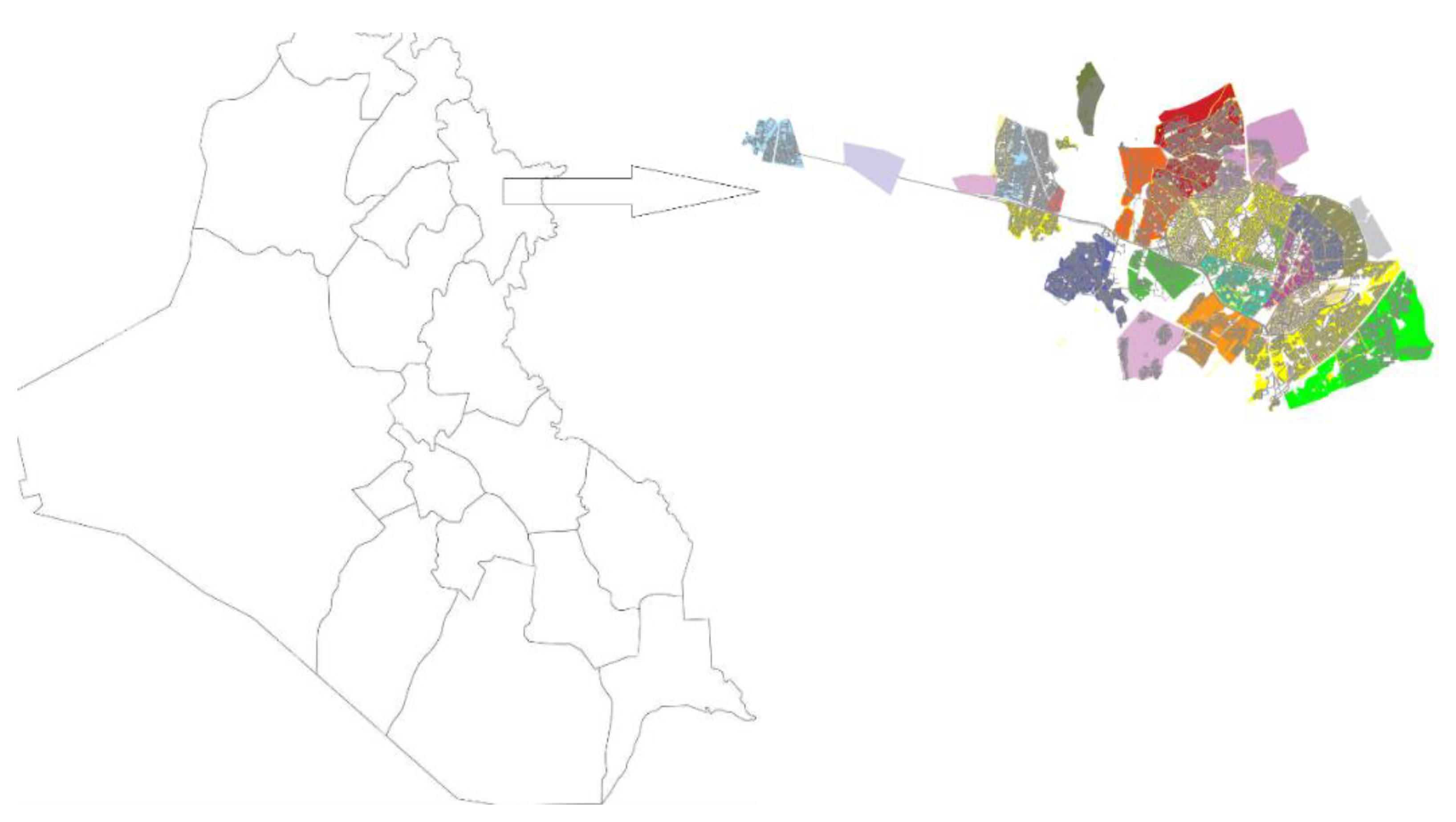

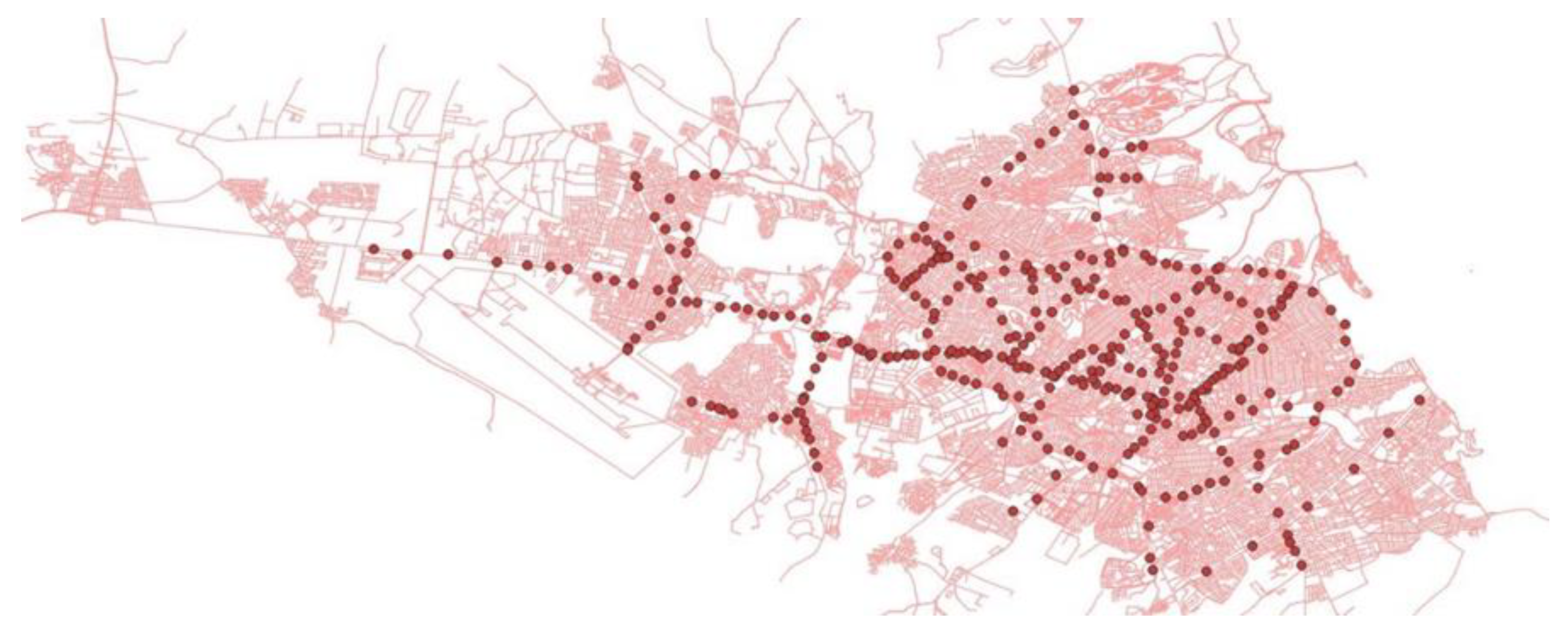

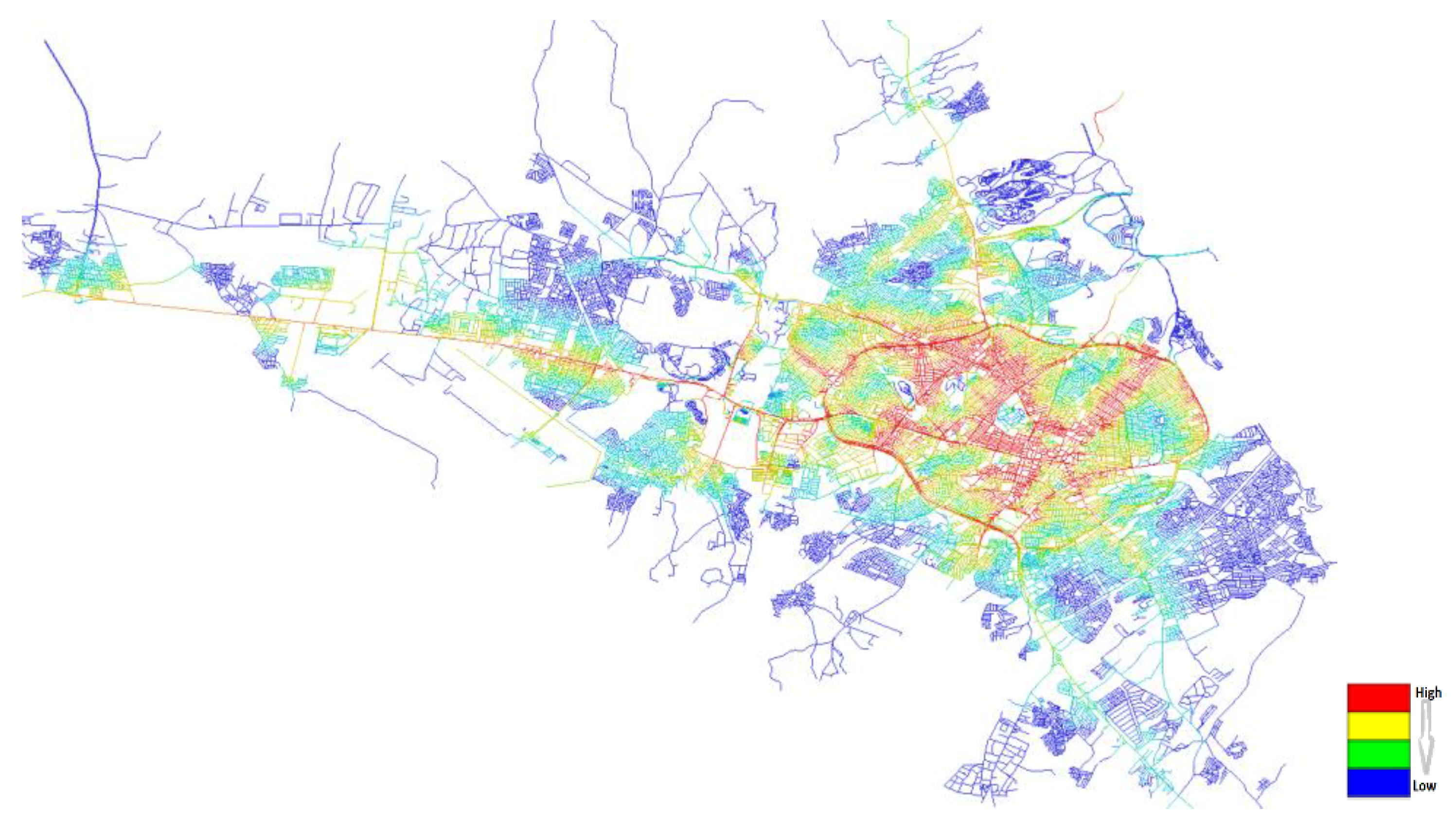

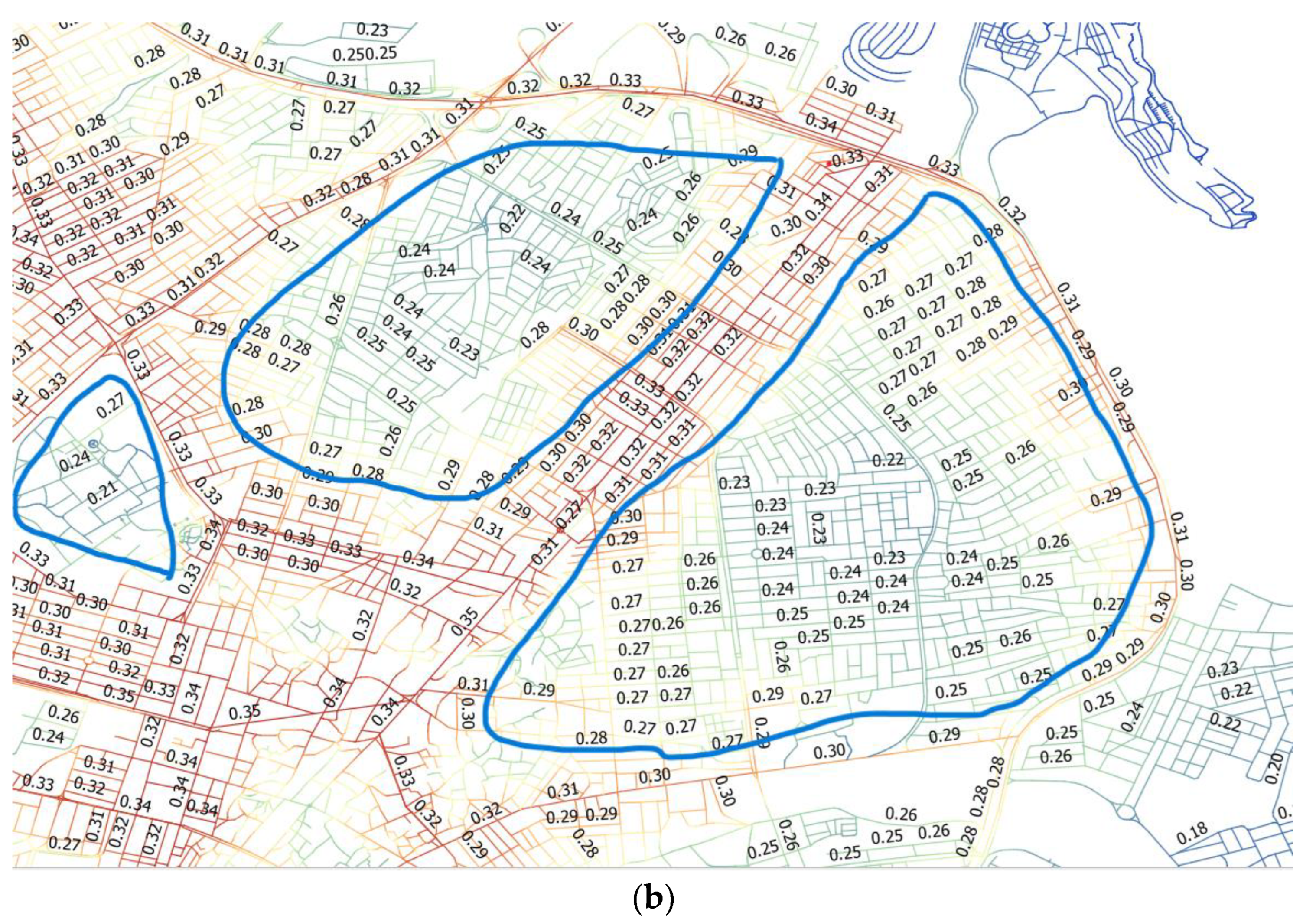
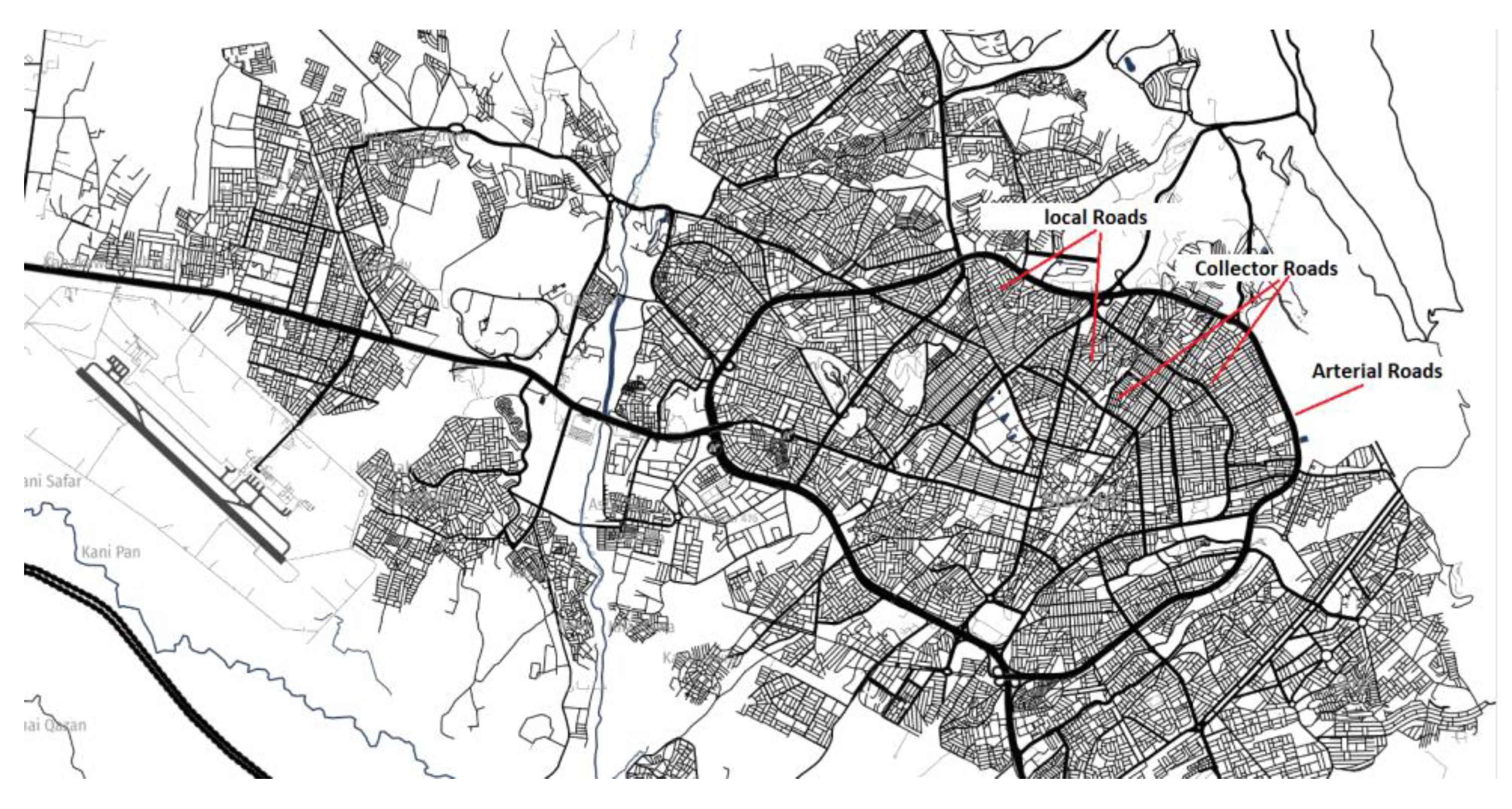
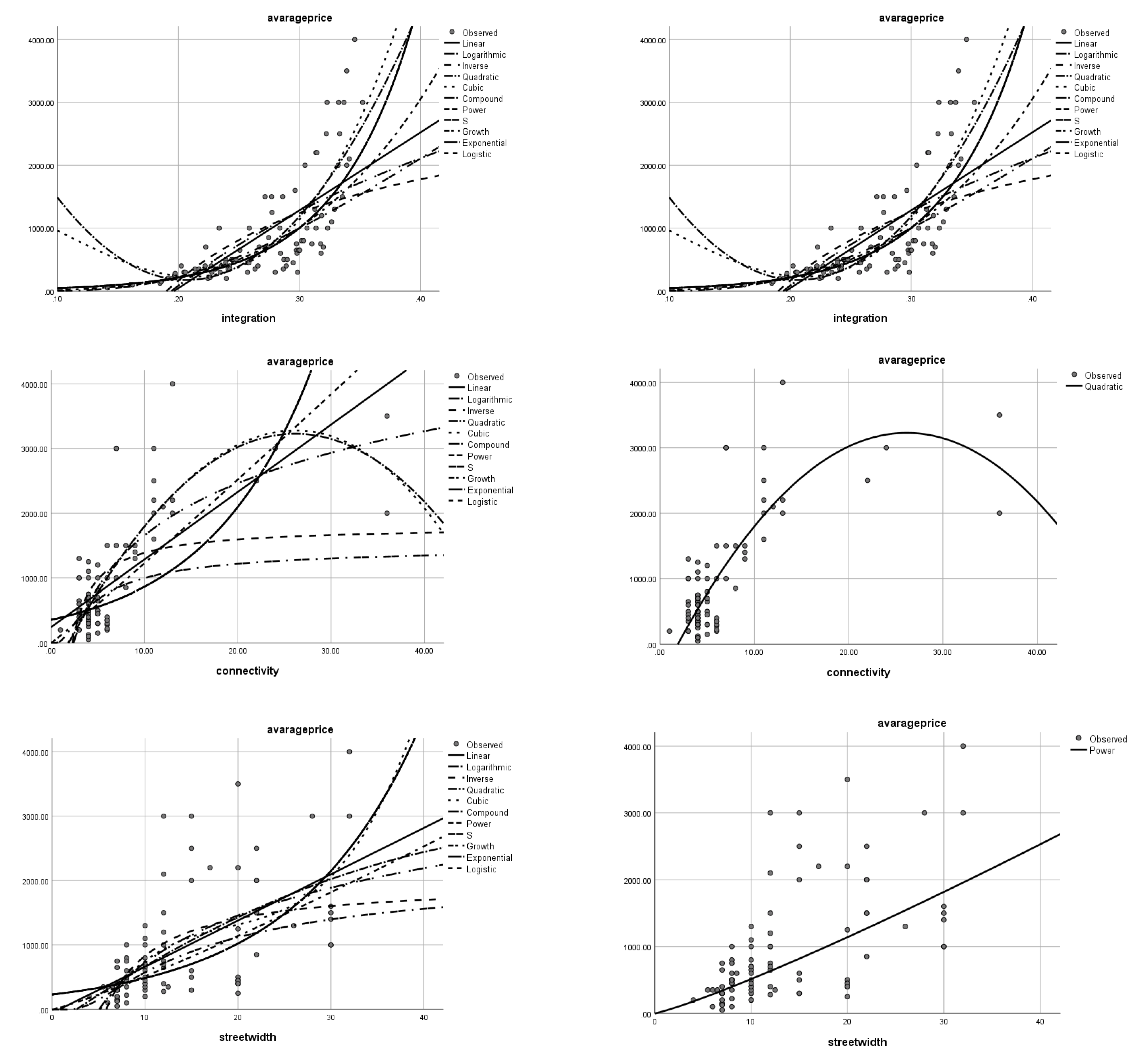
| Sulaymaniyah City Land Price | ||||
|---|---|---|---|---|
| Lowest Price per m2 (USD 60–USD 200) | Low Price per m2 (USD 250–USD 450) | Median Price per m2 (USD 500–USD 950) | Highest Price per m2 (USD 1000–USD 1500) and More | More than USD 2000 Price per m2 |
| QAlawa Farmanbaran Residential | Bakrajo residential Kareza wshk residential Sabunkaran Mamostayan residential Majy bag residential Khabat residential Bakrajo residential Rapareen Residential | Zargara residential Ashty residential Ali najy residential Kareza wishk commercial Slemany new residential Serchnar Residential Bakrajo commercial Rzgary residential Farmanbaran commercial Bakhtiary Residential Kurdsat Residential Hawara barza residential Azadi residential Goizha Residential Dabashan residential Mamostayan Chwar bax residential Pasha city residential Qaiwan city Ibrahim ahmad Residential Darwaza city Zerin Hawary Shar Residential | Sarchnar commercial Zargata commercial Slemany new commercial Mamostayan commercial Majy bag commercial Malkany commercial Khabat commercial Azadi commercial Tuy malik Residential Ibrahim ahmad Rzgary commercial Farmanbaran commercial Aqary Residential Kurdsat commercial Hawara barza commercial Goizha commercial Dabashan Commercial Chwarbax commercial Hawry Shar commercial Rapareen commercial Baxan | The city center Saholaka Tuy malik Comercial AshtyCommercial Serchnar Commercial Aqari commercial Bakhtiary commercial Ali najy commercial |
| (a) Integration model summary and parameter estimates | ||||||||
| Dependent Variable: average price | ||||||||
| Equation | Model Summary | Parameter Estimates | ||||||
| R Square | F | df1 | df2 | Sig. | Constant | b1 | ||
| Exponential | 0.734 | 256.025 | 1 | 93 | 0.000 | 9.849 | 15.408 | |
| The independent variable is integration. | ||||||||
| (b) Connectivity model summary and parameter estimates | ||||||||
| Dependent Variable: average price | ||||||||
| Equation | Model Summary | Parameter Estimates | ||||||
| R Square | F | df1 | df2 | Sig. | Constant | b1 | b2 | |
| Quadratic | 0.646 | 83.832 | 2 | 92 | 0.000 | -520.933- | 286.663 | -5.481- |
| The independent variable is connectivity. | ||||||||
| (c) Street width model summary and parameter estimates | ||||||||
| Dependent Variable: average price | ||||||||
| Equation | Model Summary | Parameter Estimates | ||||||
| R Square | F | df1 | df2 | Sig. | Constant | b1 | ||
| Power | 0.400 | 62.112 | 1 | 93 | 0.000 | 36.391 | 1.150 | |
| The independent variable is street width. | ||||||||
| Model Summary | ||||
|---|---|---|---|---|
| Model | R | R Square | Adjusted R Square | Std. The Error in the Estimate |
| 1 | 0.875 a | 0.766 | 0.758 | 413.64221 |
| ANOVA a | ||||||
|---|---|---|---|---|---|---|
| Model | Sum of Squares | df | Mean Square | F | Sig. | |
| 1 | Regression | 50953224.498 | 3 | 16984408.166 | 99.266 | 0.000 b |
| Residual | 15570088.660 | 91 | 171099.875 | |||
| Total | 66523313.158 | 94 | ||||
| Coefficients | ||||||
|---|---|---|---|---|---|---|
| Model | Unstandardized Coefficients | Standardized Coefficients | t | Sig. | ||
| B | Std. Error | Beta | ||||
| 1 | (Constant) | −1979.578 | 249.204 | −7.944 | 0.000 | |
| integration | 7583.791 | 1002.309 | 0.438 | 7.566 | 0.000 | |
| connectivity | 57.733 | 8.779 | 0.388 | 6.576 | 0.000 | |
| Street width | 35.413 | 6.698 | 0.299 | 5.287 | 0.000 | |
Disclaimer/Publisher’s Note: The statements, opinions and data contained in all publications are solely those of the individual author(s) and contributor(s) and not of MDPI and/or the editor(s). MDPI and/or the editor(s) disclaim responsibility for any injury to people or property resulting from any ideas, methods, instructions or products referred to in the content. |
© 2023 by the authors. Licensee MDPI, Basel, Switzerland. This article is an open access article distributed under the terms and conditions of the Creative Commons Attribution (CC BY) license (https://creativecommons.org/licenses/by/4.0/).
Share and Cite
Abdulla, H.M.; Ibrahim, M.A.; Al-Hinkawi, W.S. The Impact of Urban Street Network on Land Value: Correlate Syntactical Premises to the Land Price. Buildings 2023, 13, 1610. https://doi.org/10.3390/buildings13071610
Abdulla HM, Ibrahim MA, Al-Hinkawi WS. The Impact of Urban Street Network on Land Value: Correlate Syntactical Premises to the Land Price. Buildings. 2023; 13(7):1610. https://doi.org/10.3390/buildings13071610
Chicago/Turabian StyleAbdulla, Hawnaz Magid, Muammal Alaaddin Ibrahim, and Wahda Shuker Al-Hinkawi. 2023. "The Impact of Urban Street Network on Land Value: Correlate Syntactical Premises to the Land Price" Buildings 13, no. 7: 1610. https://doi.org/10.3390/buildings13071610
APA StyleAbdulla, H. M., Ibrahim, M. A., & Al-Hinkawi, W. S. (2023). The Impact of Urban Street Network on Land Value: Correlate Syntactical Premises to the Land Price. Buildings, 13(7), 1610. https://doi.org/10.3390/buildings13071610








